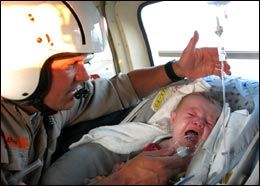Related Video: The Pediatric’s Corner at EMS Today 2008
What about the kids?
 Courtesy file photo A UT Lifestar flight nurse attempts to comfort an infant patient during a flight to the University of Tennessee Medical Center. |
These are the legendary words of Dr. Martin (Marty) Eichelberger, founder of the Emergency Medical Services for Children program, who began his call for action many years ago, one which continues to resonate throughout America. Over the past three decades, the advancements in the level of care provided to ill and injured children continue to move forward, due in part to these simple words.
Thousands of health care professionals have stepped up to assure America’s children are properly cared for. So what have you done? For most of us, we simply do what is required; take continuing education courses, carry pediatric care references, and give our pediatric patients the best we can. But is that enough? Absolutely not. We can absolutely do more.
One way is to get involved in celebrating National EMS Week and, more specifically, National EMS for Children Day, designated on the Wednesday of EMS Week every year.
It began back in 1999 while working as the National EMS Systems Director for the EMSC National Resource Center in Washington, D.C. Wayne Neal and I began looking at methods to honor the hundreds of thousands of men and women who provide emergency care to ill and injured children. The American College of Emergency Physicians and the National Highway Traffic Safety Administration already had established National EMS Week, so what could be done? National EMS for Children Day, of course!
The executive director, Jane Ball, explored the concept and told us to investigate the interest out in the community. A number of childcare advocates stepped forward, such as Dr. Lou Romig, Dr. Arthur Cooper, Dr. Karen Frush, Cyndy Wright-Johnson, Breck Rushton, Dr. Linda Quan, and many others. I then had a conversation with Rick Murray, EMS manager for ACEP, who enthusiastically encouraged the development of a special day and recommended I also talk to Jeff Michaels, chief of EMS at NHTSA, who became a proponent in our efforts.
For the next several months, hundreds of people were contacted, letters written, phone calls made, letters of support received, and the ground work laid. By that summer, we had formulated a plan to celebrate and recognize EMS providers who care for children.
The plan consisted of first approaching congressional leadership to see if they would promote a national proclamation. Senators Daniel Inouye (D – Hi) and Orin Hatch (R – Ut), legislative founders of EMSC, both became fast supporters. Next was developing information to be included in the ACEP EMS Week packet. While there was a wealth of resources available, the challenge was narrowing down the list.
Due to federal policies that prohibit a federal program from asking more than seven people the same question, we relied on two to three of the most active EMSC state coordinators for input, who in turn opened up the dialogue to the entire EMSC family. The result was an EMSC Day information packet that quickly became the best of the best.
Lastly, we had to plan a celebration to announce the launch to the nation. While I originally thought a huge press conference in D.C. was necessary, having numerous small celebrations at local hospitals, ambulance services, and communities would be much more effective and reach more children. Without pause, states across the US began announcing plans to honor EMSC Day. A “national” ceremony took place at the Children’s National Medical Center in Washington, and with the help from many providers and health officials dedicated to pediatric health care, National EMSC Day became official on May 24, 2000.
Now, eight years later, caring for the ill and injured child in the prehospital and emergency department environment continues to be a significant challenge. Despite more than 25 years of effort, many EMS providers and ED staff still don’t have access to the educational opportunities required to provide them with the foundational knowledge and skills needed to properly care for children.
Pediatrics continues to be one of the weakest content areas in EMS training programs. The typical “child not breathing” call from a frantic 911 caller still puts fear in the heart of many providers because we care a great deal for our littlest patients. After so many years, so much effort, and so many opportunities, why do we still not have the tools, knowledge, skills, and equipment to properly care for children?
The answer, in part, is that caring for patients — and especially children — is a lifelong learning process. We’re getting there. Like most great things in life, it is a process. A process that we have become so familiar with that we often fail to see the progress we’re made — just like seeing your own children grow gradually every day. We have raised the standards well above where they were 25 years ago. The new Educational Standards have an entire section dedicated to pediatrics. The recent paramedic and EMT training manuals have expanded their chapters on pediatrics, and there are various continuing education programs specializing in emergency pediatric care. We have raised the standard of care, but have plenty of room to continue our progress.
Where will be in the next 25 years? I personally hope that EMS will have evolved into the public health profession it is capable of being: responding to emergencies, caring for the ill and injured, and providing them with expanded healthcare options that the visionaries from the EMS Agenda for the Future have started to explore.
Once again, we must seek to answer Eichelberger’s question: What about the kids?
Their future is in our caring hands.
Needs ideas or tips on how to celebrate National EMSC Day at your department?
Visit the EMS1 Tips section to get started!












